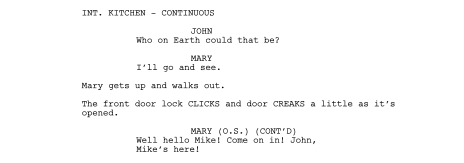We’ve looked previously at the elements of a screenplay, but what about writing one? Are there any rules about how to do this? Well, not exactly. But we do have some great tips to share, so check out our guide below to find out more about writing scripts and screenplays.
1. Read Other Scripts
Maybe you want to write a script because you’re a big fan of cinema. But have you ever tried reading a movie rather than watching one? This is a great way to see how most movie scripts use a three-act structure, as well as offering insights on how to write and format dialogue.

Try reading different types of script, too. For example, as well as reading the screenplay for your favorite movie, you can read one for a short film and an episode of a TV show. This will give you a better sense of how screenplays can vary and what you might want to write.
2. Create a Screenplay Outline
Once you have an idea of the story you want to tell, you’ll be ready to outline your screenplay. This is like a blueprint for the screenplay proper. The amount of detail in an outline may vary, but it should include a breakdown of each act and scene you plan to include in the finished version. This will let you work out and finalize the story before you write it up in screenplay form.
3. Show, Don’t Tell
Having a narrator in a screenplay is fine when done well, but it’s almost always better to use action to drive the story forward.
So, instead of relying heavily on exposition, you should:
Find this useful?
Subscribe to our newsletter and get writing tips from our editors straight to your inbox.
- Use strong action verbs wherever possible. For example, instead of saying someone is “running,” you could use a more descriptive term like “galloping” or “dashing” to reflect the tone or character of the scene.
- Let characters show who they are through dialogue and action. If you see your protagonist as “combative,” for instance, include a scene to establish this early on via the action (e.g., a confrontation between characters).
- Avoid unnecessary exposition by presenting story information as part of the action. If a character is talking at length about something that happened in the past, for example, you could instead insert a flashback to show the audience what happened.
The key is that film and TV are primarily visual media, so “telling” the audience something is often a missed opportunity. By foregrounding action, on the other hand, your screenplay will become more dynamic.
4. Focus on the Writing
It can be tempting to fill a script with stage or camera directions if you have an idea of how it should look. But unless you’re also directing the final version, this may not be your job!
You should, of course, describe the action as best you can. But you can leave out mentions of close ups or instructions about scene transitions for now. These are usually added later in a shooting script, which comes after a studio has already bought a screenplay (or spec script).
Summary: How to Write a Screenplay
If you want to write a screenplay, there are a few things you might want to do:
- As well as watching movies and TV shows, read a range of scripts to get a sense of how they are presented and constructed.
- Outline the story, breaking it down by act and scene. This can help you work out story issues before you begin the screenplay.
- Remember that film and TV are visual media. As such, it is best to avoid too much exposition. Instead, use action to drive your story forward.
- Don’t worry about stage or camera directions in the first draft (unless you will be directing it yourself). Focus first on action and story.
And, finally, don’t forget to have your screenplay checked by a professional to make sure it is error free and easy to read throughout.



